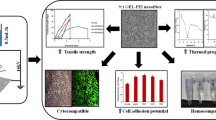Abstract
Hydrogels are polymeric substances with hydrophilic features, which make them capable of holding large volume of liquids in their three-dimensional network structures. Hydrogels are finding wide ranges of applications in several biomedical, industrial, and environmental fields. In this study, hydrogels were prepared using chitosan powders, and reinforced with electrospun poly (methyl methacrylate) (PMMA) and poly vinyl chloride (PVC) nanofibers. The chitosan hydrogels were produced by dissolving chitosan in 1% acetic acid solution and mixing thoroughly. Gentamycin, an antibacterial agent, was also added to further increase the effectiveness of hydrogels for biomedical purposes. The prepared hydrogels were subjected to swelling, Fourier-transform infrared spectroscopy (FTIR) and compression tests. The test results showed that hydrogel provided very high-water absorption capacity (10–11 folds). FTIR studies conducted on the hydrogel samples with different percentages of inclusions revealed that some of the compounds were covalently bonded in the structures, which directly affect the mechanical strength and liquid absorption capacity. The compression tests performed at different loads indicated that PVC and PMMA nanofibers reinforced hydrogels provided up to 75% much higher compression strengths when compared to the base-case (without any reinforcement).








Similar content being viewed by others
References
Ahmed EM (2015) Hydrogel: Preparation, characterization, and applications: A review. J of Adv Res 6:105–121
Ahmed EM, Fatme AS, Awad MA, EL-Aref AAT et al (2013) An innovative method for preparation of nanometal hydroxide superabsorbent hydrogel. Carbohydr Polym 91:693–698
Buchholz FL, Graham TA et al (1998) Modern superabsorbent polymer technology. Wiley-VCH, New York
Brannon-Peppas L, Harland RS et al (1991) Absorbent polymer technology. J Controlled Release 17(3):297–298
Yuhui L, Guoyou H, Xiaohui Z, Li B, Yongmei C, Tingli L, Tian Jian L, Feng X et al (2013) Magnetic hydrogels and their potential biomedical applications. Adv Func Mater 23(6):660–672
Horie K, Baròn M, Fox R, He J, Kahovec HM, Kitayama J, Kubisa T, Marèchal PE, Mormann W et al (2004) Definition of terms relating to reactions of polymers and to functional polymeric materials Pure Appl. Chem 76:889–906
Ahmadi F, Oveisi Z, Mohammadi Samani S, Amoozgar S et al (2015) Chitosan based hydrogels: Characteristics and pharmaceutical applications. Res in Pharm Sci 10(1):1–16
Hamidi M, Azadi A, Rafiei P et al (2008) Hydrogel nanoparticles in drug delivery. Adv Drug Deliv Rev 60:1638–1649
Peppas NA, Bures P, Leobandung W, Ichikawa H et al (2000) Hydrogels in pharmaceutical formulations. Eur J Pharm Biopharm 50:27–46
Kim SJ, Park SI, Kim SL et al (2003) Swelling behavior of interpenetrating polymer network hydrogels composed of poly (vinyl alcohol) and chitosan. React and Funct Polym 55:53–59
Giri TK, Thakur A, Alexander A, Badwaik H, Tripathi DK et al (2012) Modified chitosan hydrogels as drug delivery and tissue engineering systems: Present status and applications. Acta Pharm Sinica B 2(5):439–449
Rohindra DR, Nand AV, Khurma JR et al (2004) Swelling properties of chitosan hydrogels. The South Pac J of Nat and Appl Sci 22:32–35
Khan WS, Ceylan ARM, Jabbarnia A et al (2013) Recent Progress on Conventional and Non-Conventional Electrospinning Processes. Fibers and Polym 14:1235–1247
Asmatulu R, Veisi Z, Uddin MN, Mahapatro A et al (2019) Highly Sensitive and Reliable Electrospun Polyaniline Nanofiber Based Biosensor as a Robust Platform for COX-2 Enzyme Detections. Fibers and Polym 20:966–974
Saeednia L, Yao L, Cluff K, Asmatulu R et al (2019) Sustained Releasing of Methotrexate from Injectable and Thermosensitive Chitosan-Carbon Nanotube Hybrid Hydrogels Effectively Controls Tumor Cell Growth. ACS Omega 4:4040–4048
Nuraje N, Khan WS, Ceylan M, Lie Y, Asmatulu R et al (2013) Superhydrophobic Electrospun Nanofibers. J of Mater Chem A 1:1929–1946
Alamir MA, Alarifi IA, Khan WA, Khan WS, Asmatulu R et al (2019) Electrospun Nanofibers: Preparation, Characterization and Atmospheric Fog Capturing Capabilities. Fibers and Polym 20:2090–2098
Reneker DH, Chun I et al (1996) Nanometer Diameter Fibers of Polymer Produced by electrospinning. Nanotechnol 7(3):216–223
Thomas YAE, Koomson A, Seniagya MPO, Cobbold GP, Kwofie SK, Asimeng BO, Arthur OK, Awandare G, Tiburu EK et al (2018) Chitosan Composites Synthesized Using Acetic Acid and Tetraethylorthosilicate Respond Differently to Methylene Blue Adsorption. Polym (Basel) 10(5):1–13
Akauru O, Isiuku BO et al (2017) Chitosan Hydrogels and their Glutaraldehyde-Crosslinked Counterparts as Potential Drug Release and Tissue Engineering Systems - Synthesis Characterization, Swelling Kinetics and Mechanism. J of Phys Chem & Biophys 7(3):2–7
Khlystov N, Lizardo D, Matsushita K, Zheng J et al (2013) Uniaxial Tension and Compression Testing of Materials, Lab Report
Huang T, Xu H, Jiano K, Zhu L, Brown HR, Wang H et al (2007) A Novel Hydrogel with High Mechanical Strength: A Macromolecular Microsphere Composite Hydrogel. Adv Mater 19(12):1622–1626
Corkhill PH, Trevett AS, Tighe BJ et al (1990) The potential of hydrogels as synthetic articular cartilage. Procs of the Inst of Mech Eng 204(3):147–155
Stammen JA, William S, Ku DN, Guldberg RE et al (2001) Mechanical properties of a novel PVA hydrogel in shear and unconfined compression. Biomater 22:799–806
Usta A, Saeednia L, Pyarasani S, Asmatulu R et al (2013) Antibacterial Hydrogels Reinforced by Electrospun PVC Nanofibers for Biomedical Applications, SAMPE Fall Technical Conference, Wichita, KS, October 21–24, 12 pages
Acknowledgement
The authors greatly acknowledge Flossie West Memorial Foundation fund for the financial support of the present study.
Author information
Authors and Affiliations
Corresponding author
Additional information
Publisher’s Note
Springer Nature remains neutral with regard to jurisdictional claims in published maps and institutional affiliations.
Rights and permissions
About this article
Cite this article
Khan, W.S., Pyarasani, S. & Asmatulu, R. Reinforcing antibacterial hydrogels through electrospun nanofiber layers for soft tissue engineering. J Polym Res 27, 380 (2020). https://doi.org/10.1007/s10965-020-02354-4
Received:
Accepted:
Published:
DOI: https://doi.org/10.1007/s10965-020-02354-4




